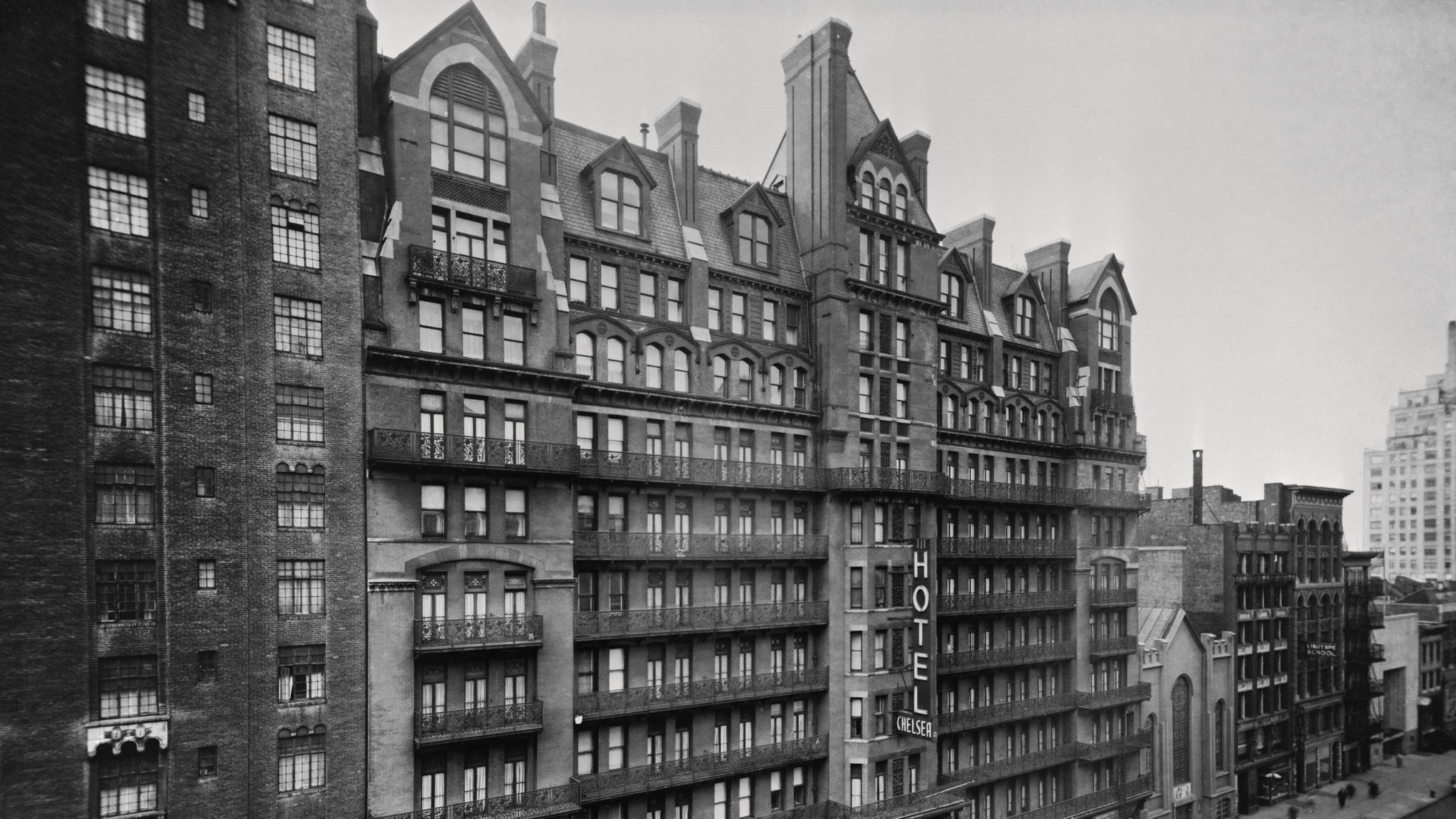The Fascinating History of Hotel Chelsea
4 November 2022
The rumors are true. New York’s Hotel Chelsea, that infamous nexus of all things bohemian, is finally opening its doors more than a decade after an abrupt change in ownership and a lengthy renovation. Legions have fallen in love with its tawdry glamour. Nearly as many have fled in horror from its scummy bathrooms and haunted corridors. However, love the Chelsea or hate it, everyone who has stayed here has a relationship with it: once the old dowager gets her talons into you, she doesn’t let go.
My own association with the Chelsea began during a summer downpour when a lightning bolt flashed just as I leaped over a puddle on West 23rd Street. Glancing up, I saw the mammoth red-brick edifice silhouetted against the roiling clouds in all its gothic glory, with the full-grown trees of its roof garden waving in the wind like women in distress. “What is that place doing there?” I asked myself. How had a gargantuan artists’ hostelry survived so long in one of the world’s most materialistic cities?
Thus began a decade-long deep dive into Hotel Chelsea lore. Many stories that surfaced were bizarre—such as the 19th-century slum girl dispatched to Bellevue asylum for claiming she lived at the glorious new hotel before it had even opened, and the concert pianist’s wife who cut off her hand and placed it on the bedside table before leaping from a window to her death. However, what became clear was that, from the beginning, the Chelsea was a haven for eccentrics, and the artists were there by design. Its architect, a French-born idealist named Philip Hubert, had conceived of the Chelsea as a cooperative where residents could decrease their living expenses by sharing costs—thereby freeing up time for creative pursuits.
The building he completed in 1884 provided soundproof walls to separate practicing pianists from working novelists. It had an elaborate roof garden for stargazing and performances; exquisite stained glass, painted murals, and a skylit central staircase for aesthetic grace. Reports soon proliferated of the director David Belasco lounging with the Frohman brothers in the lobby, Mark Twain pontificating in the dining room and Isadora Duncan dancing upstairs. Even after the turn of the century, when the cooperative failed financially and the Chelsea became a residential hotel, its aura of Gilded Age utopianism continued to appeal to New Yorkers’ idealistic side.
The Great Depression was good for the Chelsea, as it succumbed to bankruptcy and was bought for a song by a syndicate of Hungarian immigrants headed by hotelier David Bard. He revered artists but lacked practicality, making him the perfect host for Dylan Thomas, Brendan Behan, Thomas Wolfe, and other alcoholics who had been banned from every respectable hotel in town. Some might complain about the noise of shattering crockery during Thomas’s domestic disputes; of Wolfe pacing the halls, reciting lines from “You Can’t Go Home Again” in the wee hours.
By 1960, when Arthur Miller retreated here after his separation from Marilyn Monroe, he found the hotel “nearly a slum”, furnished with inexpensive pieces and with “something like coal dust” crunching beneath his shoes. Yet he also found a flourishing artistic life: composer Virgil Thomson producing extraordinary dinners from his wardrobe-sized kitchen for renowned figures like Edith Piaf and Leonard Bernstein. The vibrant energy of the Chelsea attracted numerous notable artists, whose works became interwoven with the fabric of the hotel’s history.
However, the atmosphere at the Chelsea was about to change significantly. The glory days were marked by an impressive artistic outpouring, where famed musicians and artists, such as Bob Dylan and Joni Mitchell, found inspiration within its walls.
Unfortunately, like his father, Stanley Bard, who took over management, was unable to see what was broken at the Chelsea. As the 1970s dragged on, the scene deteriorated with dealers roaming the halls, and junkies occupying the bathrooms. The unfortunate events surrounding the deaths of Nancy Spungen and Sid Vicious became synonymous with the hotel’s decline, marking a turning point in its storied history.
In 2007, as the landscape of New York continued to evolve, the hotel was sold and underwent a comprehensive renovation. Now, the once-great Hotel Chelsea is ready for a resurgence, redesigned as a sophisticated establishment with a focus on restoring its artistic heritage.
Address: 222 W 23rd St, New York, NY 10011, United States
Price: Doubles from about £400




